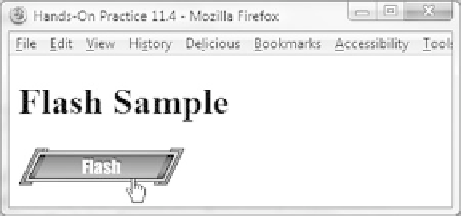HTML and CSS Reference
In-Depth Information
The Flash object uses special values, called parameters, to configure the name of the
.swf file, quality of the media, and background color of the page areas. These are
configured with
<param />
or parameter tags. Parameters used with Flash media are
shown in Table 11.4.
Table 11.4
Flash media parameters
Parameter Name
Parameter Value
File name of the Flash media (.swf file)
movie
Optional; Describes the quality of the media; usually the value
high
is used
quality
bgcolor
Optional; Background color of the Flash media area; uses a hexadecimal color value
Optional; Indicates whether the .swf loops; values are “true” and “false”
loop
Optional; Configures transparent background of the Flash media area in browsers that
support this feature; value is “transparent”
wmode
All the
<param />
tags for the object appear before the ending
</object>
tag. An
example will be given later in this section. An overview of this tag placement follows:
<object ...
object attributes go here
...
<param name="movie" ...
value attribute goes here
... />
<param name="quality" ...
value attribute goes here
... />
<param name="bgcolor" ... />
<p>XHTML code placed here will display if the <object> is not
supported by the browser.</p>
</object>
Focus on Accessibility
Notice the code placed before the closing
</object>
tag in the example above. It is dis-
played if the browser does not support the multimedia object. Include a link to a Web
page containing alternate text content if needed. While the developers of assistive tech-
nologies such as screen readers are working toward the support of Flash media, it is not
yet universal.
WWW
HANDS-ON PRACTICE 11.4
In this Hands-On Practice you will launch Notepad and create a Web page that displays
a Flash button. Your page will look like the one shown in Figure 11.9, which can be
found in the student files at Chapter11/flash.html.
Figure 11.9
Flash sample





Search WWH ::

Custom Search